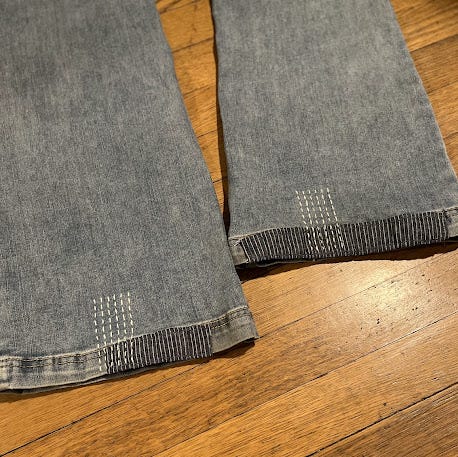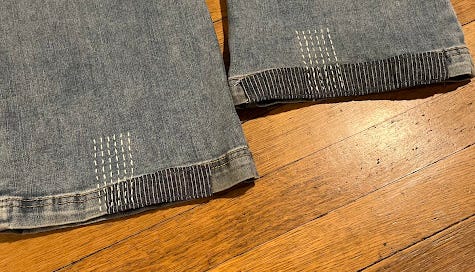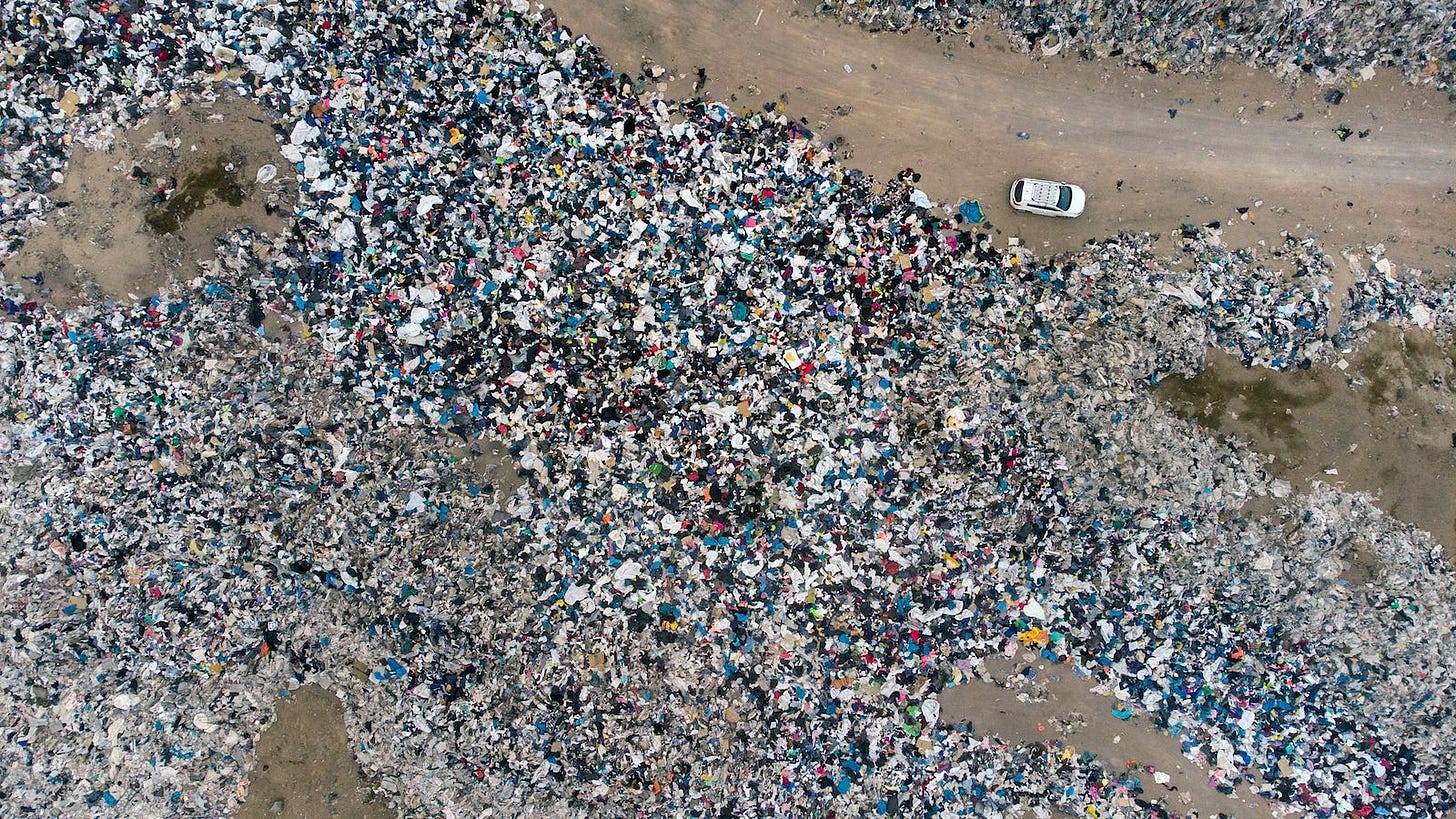We reap what we sew
My friend Hannah on circular textiles. Fast fashion is literally toxic. On (finally) learning how to do laundry. Adventures in visible mending.
My friend Hannah owns and operates a small sustainable business, the Cleveland Sewing Company. She uses industrial salvaged eco-friendly fabrics to make durable fashion and household items. Recently I had the pleasure of talking with her about textile circularity. She’s building on what she knows and learning from places like North Carolina to try to stand up a circular textiles ecosystem here in Northeast Ohio.
Hanging out with Hannah is educational and inspiring. She’s working on systems change, but what can everyday people do to support circularity in textiles? This question led me down a rabbit hole (laundry chute?) I’d like to share. Follow me?
Fast Fashion is Literally Toxic
We need to wake up to the impacts of fast fashion—a business model that encourages rapid consumption of cheap, low-quality clothing. The industry relies on cheap labor, a throwaway culture, and marketing that seeds an inherent dissatisfaction with ourselves that we are told we can fix with clothes.
Research shows a real disconnect between attitudes around sustainable fashion and actual consumption of fast fashion. I think this may be because the system is designed to make it difficult to make better choices.
I wrote about churn in my post, Buy Nothing, and how we can be more thoughtful and slow down our personal buying cycle.
We are a nation that tends towards extremes, and our attitudes about consumption are no exception, but wherever you are on the spectrum, you are likely doing your thing with increasing speed.
While secondhand fashion markets are a good thing, supply is outpacing demand. Receiver countries are grappling with actual mountains of discarded clothing from wealthier nations, contributing to soil, water and air pollution.
The low quality of fast fashion is one part of the problem. In Kenya, In 2021, about 458 million of the 900 million used clothing imported in Kenya were worthless.
The link between poor fashion waste disposal and water pollution in Africa is undeniable. In Ghana, it is evidenced by the conditions of the Korle Lagoon, whose banks consist of a landfill that is mostly made up of unused clothing shipped from the Global North. The water body, which was once a source of livelihood and recreation for Accra’s residents, now ranks among the most polluted water bodies globally, with the fashion waste build up along its shores worsening the situation.
In Ghana clothing waste is washing ashore its beaches faster than volunteers can remove it choking wildlife, creating pollution and rendering the beaches unusable.
In the Chilean desert a mountain of clothes, mostly synthetic, caught fire from the sun, heat and dry conditions. The mound of discarded fabric in the middle of the Atacama weighed an estimated 59,000 tons.
The pollution from fast fashion in these countries is visibly untenable, but there are less obvious impacts across the globe. A new study found microplastics in 99% of seafood samples, with the highest levels in shrimp. Over 80% of these plastics came from clothing and textiles—and they’re not just in seafood. Other studies have found them in all tested meat and produce too. The textile industry is the third-largest consumer of plastic, just behind packaging and construction.
New research is coming out that shows that wearing synthetic fabrics next to our skin can harm our bodies. Here’s one and here’s another. Alden Wicker has a great post on it.
Going Natural
Hannah told me that today’s synthetic blend fashions are nearly impossible to recycle and that blended fibers can be shredded and downcycled for fill or insulation, but they are rarely re-spun and turned back into fabrics. There are some advances in chemical recycling for synthetic textiles but they have their own issues around waste and energy .
Given that synthetics are contributing to flammable trash piles, microplastic pollution and personal toxicity, and they are also hard to recycle the obvious choice is wearing more natural fibers like wool, silk, cotton, linen, bamboo and hemp.
But it’s hard to find natural, un-blended clothes and fabrics, even at high end stores. And when you find them they can be pricey. As I’m making the transition away from synthetics, I’ve found ThredUp, a secondhand clothes app, to be a great tool. They’ve added search filters that allow you to define fabric types, in addition to brand, condition, color, size, etc. My recent purchases are a navy silk blouse, a wool sweater vest, a denim skirt and a linen camp shirt.
When shopping locally at thrift and consignment stores, I have trained my eyes and fingers to identify natural fabrics. They hang differently, they feel nice in your hands. The sweaters have a warmth, silk doesn’t catch on your skin, linens drape.
Laundry Love
Once I started shifting my wardrobe to more durable, higher quality, natural fabrics, I realized that I needed to learn how to wash them properly. These clothes are now investments. I’ve been doing my own laundry since I was a child, but I have relied on dry cleaning for items I was afraid to shrink or damage. I set out to learn how to wash cotton, linen, silk and wool items and to get stains out of my clothes. The book Laundry Love was a great resource and a pleasure to read. Fun fact: you can wash your clothes in actual soap and arm yourself with an arsenal of effective stain removers.
Fix it First
Real clothes are worth mending. I learned to knit in undergrad. One of my majors was dance performance and the combination of backstage tech time and my need for leg warmers made it inevitable. I later refined my skills when I worked part-time at a knitting store in my 20’s when I was a modern dancer. While knitting is a skill I am comfortable with, I’ve never been confident about sewing.
The zeitgeist gerbils put visible mending in my algorithm and I think it might be a game changer for me. Rather than trying to be so good at sewing that repairs are invisible, I can be creative about how they show up.
I recommend the book Visible Mending by Arounna Khounnoraj. I’ve learned how to darn my wool socks, and had fun repairing my worn pant cuffs. My kids have some fun patches on their knees too.

Slowing down our personal fashion cycles through repair matters. Skye Pennant posts in Slow Stitch Club on the impacts of fixing our clothes. Studies show it can displace the need to replace our clothes by 82% and over 3 in 5 second hand purchases displace purchase of new items.
Fast fashion is a downward spiral of chasing the latest styles at the lowest price and the highest cost to society and the environment. I think we can all be a part of the solution by slowing down, buying recyclable and repairable items and paying more attention to what is happening to the world around us.
What if the best fashion is to simply wear one’s values? Wouldn’t we all just look so beautiful?








